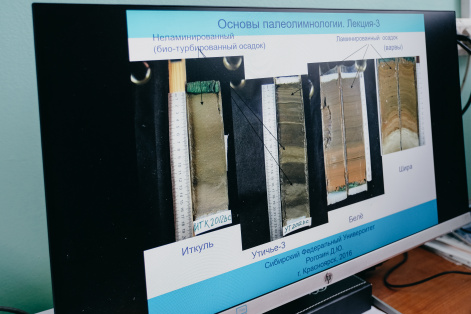Bottom sediments shed light on the history of human settlement in the vicinity of Lake Shira
16 April 2024 г.

Lake Shira, located in the south of Siberia in the Republic of Khakassia, is a popular resort. It stores a whole historical chronicle at its bottom. Bottom sediments, like tree rings, accumulate over time. Every year a new layer settles at the bottom of the water reservoir, preserving the imprints of important historical processes. By studying the composition of the layers, one can learn about the events which took place in a particular era.
Scientists from the Krasnoyarsk Science Center SB RAS and Siberian Federal University for the first time reconstructed the history of the settlement of Lake Shira using biochemical data in bottom sediments over the last millennium. The results obtained can be useful for identifying the historical dynamics of colonization of the area and the presence of humans there, as well as for monitoring the efficiency of wastewater treatment plants.
In the intestines of humans and animals, specific organic substances, stanols, are synthesized - the result of the cholesterol processing. Moreover, humans synthesize specific stanol called coprostanol. Once in water bodies, these substances can accumulate and remain in bottom sediments for thousands of years. Therefore, they can serve as an indicator of the migrations of ancient peoples.
A study by Krasnoyarsk scientists shows that the relative proportion of coprostanol was higher in the sediments corresponding to the periods with high anthropogenic load. These include the heyday of the medieval state of the Yenisei Kyrgyz (9-11 centuries AD), the period of mass colonization by the Russian population (17-18 centuries), as well as in the 19-20 centuries characterized by the development of resort activities. This increase in the relative content of coprostanol in the bottom sediments may indicate an increased human presence in the vicinity of the lake. The results obtained can be used to identify the historical dynamics of human presence in the study area and to more accurately assess the anthropogenic load.
“The study of the lake sediments for the presence of fecal residues is one of the newest areas in paleolimnology. Our work is the first such study in Siberia. We have found that the increase in the proportion of these substances in the lowest part of the lake core corresponds to the existence of the state of the Yenisei Kyrgyz, which reached its greatest prosperity in the 9-11 centuries AD. It is likely that the population during this period may have been larger than in subsequent centuries, when the area experienced decline following the Mongol invasion in the early 13th century. The next surge in human presence, recorded by stanols, can probably be explained by an increase in the population during the period of active development of this area by the Russian state in the 17th-19th centuries. The current increase in coprostanol content may be associated with the development of resort activities in the 20th and 21st centuries,” said Denis Rogozin, Doctor of Biological Sciences, leading researcher at the Institute of Biophysics SB RAS.
The study was supported by the Russian Science Foundation (No. 22-17-00185).
Share:
